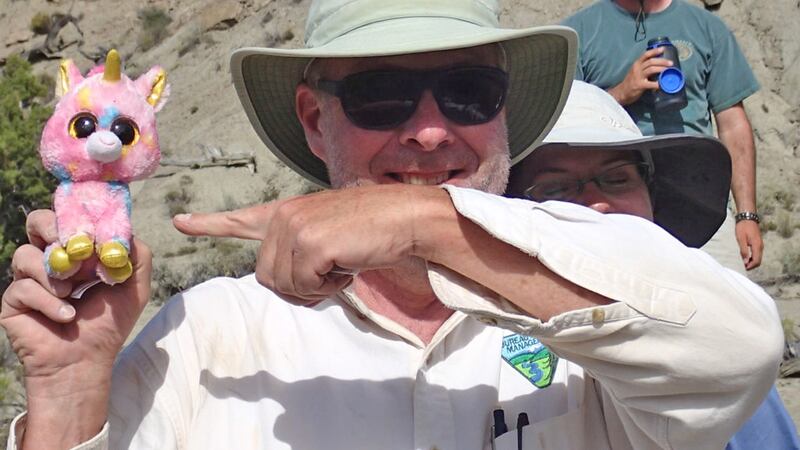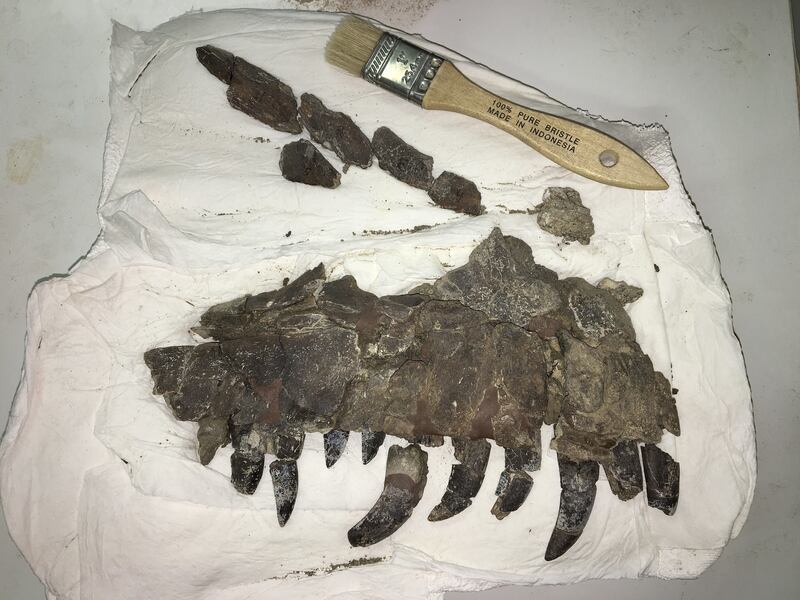Researchers discovered a pile of dinosaurs at the Grand Staircase-Escalante National Monument — a family of the giant Tyrannosaurus rex — that leads them to conclude they all died at the same time in the same flood event and were hanging out together in a “gregarious” social unit.
The Rainbows & Unicorns Quarry at the southern Utah site is groundbreaking because the mainstream narrative around these dinosaurs that roamed the Earth 76.4 million years ago is that they were solitary prey animals that lacked the sophistication to carry out a coordinated attack to deliver their next meal.
“That takes a fair amount of brain power,” according to Alan Titus, the Bureau of Land Management’s Paria River District paleontologist.
Titus said the finding is “somewhat controversial” because the 2014 find illustrates the giant dinosaurs traveled together and likely teamed up in kills — like prides of lions or wolf packs do today. Paleontological researchers have been mostly dismissive of the notion the giant meat-eating dinosaurs were capable of such social action.
In this find, scientists unearthed a family of four, possibly five individuals of the T. rex, including a young juvenile about 4 years old and a fully developed adult in its mid-20s.
The site was peeled back using an array of scientific techniques that reveal this is the first tyrannosaur mass death site found in the southern United States. Using a battery of tests and analyses on the vestiges of the original site, researchers found the dinosaurs perished in a single flood event, were buried in fine mud, unearthed and reburied in a sandbar.
“And there it is, a very sad day in southern Utah 76 million years ago,” Titus said.

The findings were released through publication in the open-access scientific journal PeerJ on Monday. They were crafted by a team of researchers from the BLM, Denver Museum of Nature and Science, University of Arkansas, Colby College of Maine, and James Cook University in Australia.
The specimens unearthed from the unique fossil bone site exceeded the expectations raised even by its lofty nickname.
Titus said the name derived from teasing from former colleagues who rib him about his perpetual excitement over any new find.
“It is always about rainbows and unicorns with me all the time,” he said, but emphasized he told his colleagues that no, this really was a rainbows and unicorns find.
Researchers remain enthusiastic that the quarry will reveal additional answers the more they dig into it.
“The new Utah site adds to the growing body of evidence showing that tyrannosaurs were complex, large predators capable of social behaviors common in many of their living relatives, the birds,” said project contributor Joe Sertich, curator of dinosaurs at the Denver Museum of Nature and Science. “This discovery should be the tipping point for reconsidering how these top carnivores behaved and hunted across the Northern Hemisphere during the Cretaceous.”
Titus explained the large predators typically don’t team up in the quest for food — they are competing against each other after all.
But as in the case of lions and wolves, which have complex and sophisticated social roles, Titus said a modern-day second cousin of the dinosaur — the Harris’s hawk — is the only known raptor to hunt cooperatively and participate in communal raising of their young.

“Localities (like Rainbows and Unicorns Quarry) that produce insights into the possible behavior of extinct animals are especially rare and difficult to interpret,” said world-renowned tyrannosaur expert Philip Currie. “Traditional excavation techniques, supplemented by the analysis of rare earth elements, stable isotopes and charcoal concentrations convincingly show a synchronous death event at the Rainbows site of four or five tyrannosaurids. Undoubtedly, this group died together, which adds to a growing body of evidence that tyrannosaurids were capable of interacting as gregarious packs.”
The idea that tyrannosaurs were social with complex hunting strategies was first formulated by Currie over 20 years ago.



